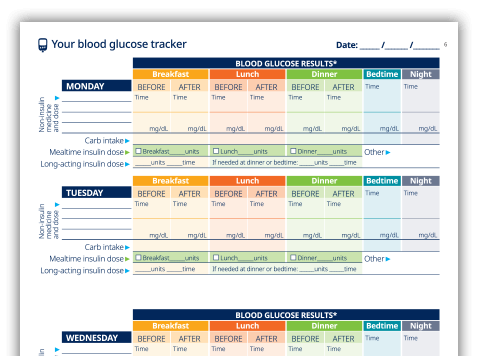Managing your diabetes
There are many healthy ways to manage your diabetes, but the right way is the one that works for you. You and your diabetes care team can work together to create a treatment plan that matches your lifestyle.
Guidelines for a healthy diet
For many individuals with diabetes, the most challenging part of a treatment regimen is determining what to eat and following a food plan.
Changing the way you eat doesn’t happen overnight—it’s a process. If you prepare for the obstacles that may get in your way, you are less likely to be discouraged. Every healthy change you make will have an effect on your diabetes care plan. Talk to your health care provider about what method of choosing and tracking your food is best for you.
Learn how different foods affect your blood sugar
Foods that can increase blood sugar spikes

Processed sugars

Starches
These foods have a high glycemic index.
Foods that can help you limit blood sugar spikes

Healthy fats

Whole grains and fiber

Protein

Some fruits and vegetables
These foods have a medium or low glycemic index.
The glycemic index is a measure of how a food will affect blood sugar based on the carbohydrates that it contains.
Looking for help on the road to healthier eating?
Check out delicious and healthy recipes available, and sign up for support at NovoCare®.
Being active and diabetes
Physical activity is an important part of your diabetes care plan. The good news is, you get to choose which activities you’d like to do. And you’re more likely to stick with activities that you like and that fit into your routine. Be sure to check with your health care provider before you start any plan to increase your physical activity.
"I'm bored..."
Try exercising while you listen to podcasts, audiobooks, or music. You might also enjoy an interactive walking/running app that turns your walk or run into a game or a story.
"I don’t have time…"
The National Institutes of Health recommends 30 minutes of physical activity a day, most days of the week—but it doesn’t have to come all at once. Just parking your car a 10-minute walk away from your house will cover 1/3 of the daily activity you need.
Activities that count as exercise
- Walking briskly or hiking
- Climbing stairs
- Swimming or water aerobics class
- Dancing
- Riding a bicycle or a stationary bicycle
- Taking an exercise class
- Playing basketball, tennis, or other sports
Blood sugar by the numbers
When it comes to diabetes, there are a lot of numbers and acronyms to remember. Learning what they mean can help you understand how to reach your blood sugar goals. Keep in mind that your daily blood sugar targets and A1C goal may be more or less than the targets below based upon what your health care provider thinks makes the most sense for you.

A1C is a blood test your health care provider performs in their office. It measures your average plasma glucose concentration, which is your blood sugar level, over the past 2 to 3 months. A1C is made up of your FPG and PPG measurements. Your A1C number will give you an idea of how well your blood sugar has been controlled over time and how well your diabetes care plan is working overall.
Recommended targets for nonpregnant adults
ADA: <7%
AACE: <6.5%

FPG stands for “fasting plasma glucose” or “fasting blood glucose” (FBG). This is your blood sugar level when you have not eaten for 8 hours. You may measure and record your FPG in the morning or when you wake up.
Recommended targets
ADA: 80 to 130 mg/dL
AACE: <110 mg/dL

PPG stands for “postprandial plasma glucose.” “Postprandial” means “after a meal”—so PPG is the measure of your blood sugar level an hour or 2 after you’ve eaten. Measuring PPG is important for keeping track of blood sugar spikes, which can tell you how well your mealtime insulin is working and how closely you may be following your food plan.
Recommended targets
ADA: <180 mg/dL
AACE: <140 mg/dL
ADA = American Diabetes Association; AACE = American Association of Clinical Endocrinologists.
Low blood sugar—what to watch out for
Sometimes, in people with diabetes, physical activity can cause low blood sugar, also called hypoglycemia. It is a good idea to bring a snack or glucose tablets in case your blood sugar gets too low while being active.
If you ever experience this while being active, write down what it felt like once you have your blood sugar under control again. That way you will start to recognize the signs of hypoglycemia and how it feels to you. Talk to your health care provider about any hypoglycemic events you experience; they may suggest a change in your treatment or level of physical activity. Learn more about the signs and symptoms of hypoglycemia at NovoCare®.
Track your numbers daily with a blood sugar tracker
Checking and tracking your blood sugar lets you and your health care provider know if your current treatment is working. Your health care provider will recommend when and how often to check it, as well as your target blood sugar range.

Leading a healthier life with diabetes can be tough, but NovoCare® is here to help
NovoCare® offers bite-sized, everyday lessons on eating better, moving more, and treating diabetes that you can learn in 5 minutes or less.

